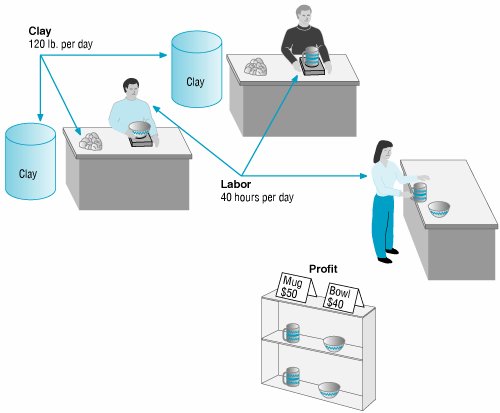A Maximization Model Example
| Beaver Creek Pottery Company is a small crafts operation run by a Native American tribal council. The company employs skilled artisans to produce clay bowls and mugs with authentic Native American designs and colors. The two primary resources used by the company are special pottery clay and skilled labor. Given these limited resources, the company desires to know how many bowls and mugs to produce each day in order to maximize profit. This is generally referred to as a product mix problem type. This scenario is illustrated in Figure 2.1.
Figure 2.1. Beaver Creek Pottery Company The two products have the following resource requirements for production and profit per item produced (i.e., the model parameters):
There are 40 hours of labor and 120 pounds of clay available each day for production. We will formulate this problem as a linear programming model by defining each component of the model separately and then combining the components into a single model. The steps in this formulation process are summarized as follows :
A linear programming model consists of decision variables, an objective function, and constraints. Decision VariablesThe decision confronting management in this problem is how many bowls and mugs to produce. The two decision variables represent the number of bowls and mugs to be produced on a daily basis. The quantities to be produced can be represented symbolically as x 1 = number of bowls to produce x 2 = number of mugs to produce The Objective FunctionThe objective of the company is to maximize total profit. The company's profit is the sum of the individual profits gained from each bowl and mug. Profit derived from bowls is determined by multiplying the unit profit of each bowl, $40, by the number of bowls produced, x 1 . Likewise, profit derived from mugs is derived from the unit profit of a mug, $50, multiplied by the number of mugs produced, x 2 . Thus, total profit, which we will define symbolically as Z , can be expressed mathematically as $40 x 1 + $50 x 2 . By placing the term maximize in front of the profit function, we express the objective of the firmto maximize total profit: maximize Z = $40 x 1 + 50 x 2 where
Model ConstraintsIn this problem two resources are used for productionlabor and clayboth of which are limited. Production of bowls and mugs requires both labor and clay. For each bowl produced, 1 hour of labor is required. Therefore, the labor used for the production of bowls is 1 x 1 hours. Similarly, each mug requires 2 hours of labor; thus, the labor used to produce mugs every day is 2 x 2 hours. The total labor used by the company is the sum of the individual amounts of labor used for each product: 1 x 1 + 2 x 2 However, the amount of labor represented by 1 x 1 + 2 x 2 is limited to 40 hours per day; thus, the complete labor constraint is 1 x 1 + 2 x 2 The "less than or equal to" ( The constraint for clay is formulated in the same way as the labor constraint. Because each bowl requires 4 pounds of clay, the amount of clay used daily for the production of bowls is 4 x 1 pounds; and because each mug requires 3 pounds of clay, the amount of clay used daily for mugs is 3 x 2 . Given that the amount of clay available for production each day is 120 pounds, the material constraint can be formulated as 4 x 1 + 3 x 2 A final restriction is that the number of bowls and mugs produced must be either zero or a positive value because it is impossible to produce negative items. These restrictions are referred to as nonnegativity constraints and are expressed mathematically as Nonnegativity constraints restrict the decision variables to zero or positive values. x 1 The complete linear programming model for this problem can now be summarized as follows: The solution of this model will result in numeric values for x 1 and x 2 that will maximize total profit, Z . As one possible solution, consider x 1 = 5 bowls and x 2 = 10 mugs. First, we will substitute this hypothetical solution into each of the constraints in order to make sure that the solution does not require more resources than the constraints show are available: and Because neither of the constraints is violated by this hypothetical solution, we say the solution is feasible (i.e., it is possible). Substituting these solution values in the objective function gives Z = 40(5) + 50(10) = $700. However, for the time being, we do not have any way of knowing whether $700 is the maximum profit. A feasible solution does not violate any of the constraints . Now consider a solution of x 1 = 10 bowls and x 2 = 20 mugs. This solution results in a profit of Although this is certainly a better solution in terms of profit, it is infeasible (i.e., not possible) because it violates the resource constraint for labor: An infeasible problem violates at least one of the constraints. The solution to this problem must maximize profit without violating the constraints. The solution that achieves this objective is x 1 = 24 bowls and x 2 = 8 mugs, with a corresponding profit of $1,360. The determination of this solution is shown using the graphical solution approach in the following section. | |||||||||||||||||||||||||||||||||
EAN: 2147483647
Pages: 358
 40 hr.
40 hr.  0,
0, 
